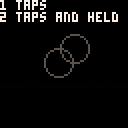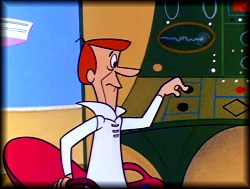

(v00 03-08-22)
TO LOAD THIS PICO-8 CART, in immediate mode, type:
load #here_on_tap

I am reminded of George Jetson from the Hanna Barbera series: "The Jetsons."
In this George had a job where he needed to press one button all day long - and that was it.
While we have greater input methods available to us, if you are programming in Pico-8 you are normally limited to the ❎ and 🅾️ buttons with the arrow keys and start or "P" to bring up additional menu options.
On a cellphone though you normally only have input - through your fingers. and as Pico-8 also lets you use a mouse for input, to navigate in pico-8 with your finger has some limitations.
-
you cannot move the X+Y mouse coordinates without actually pressing down the mouse button each time.
- you can only register one press at a time.
So how could you register multiple values from a single finger ? That is what this code explores.
You can tap singly, doubly, or even 3-at a time. It also determines if you held your finger down on the last tap, so using this you could generate multiple conditions to test for.
With my earlier "Swiper" found HERE:
https://www.lexaloffle.com/bbs/?tid=27757
You now have new ways of entering input into a cellphone.
If you find these useful, please let me know and I will combine the two into one modern code for cellphone input for you.
[Please log in to post a comment]






